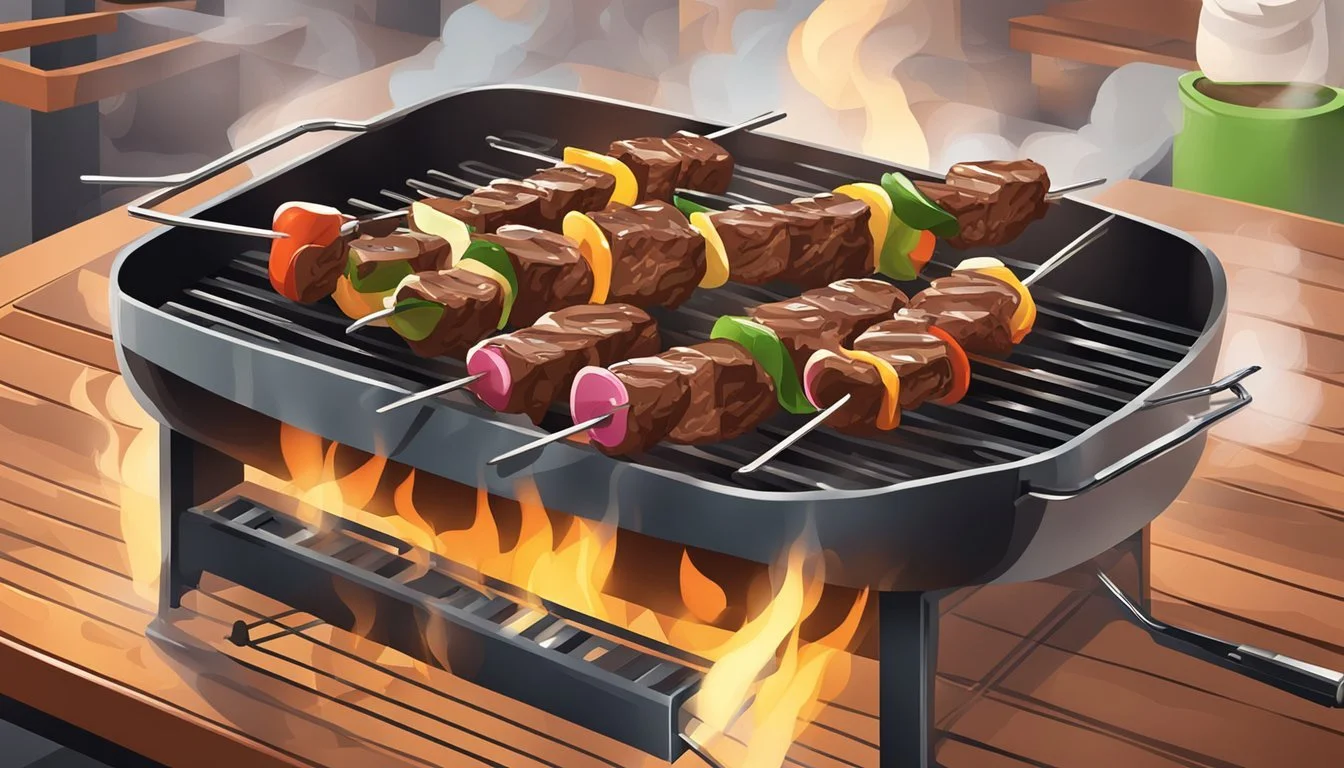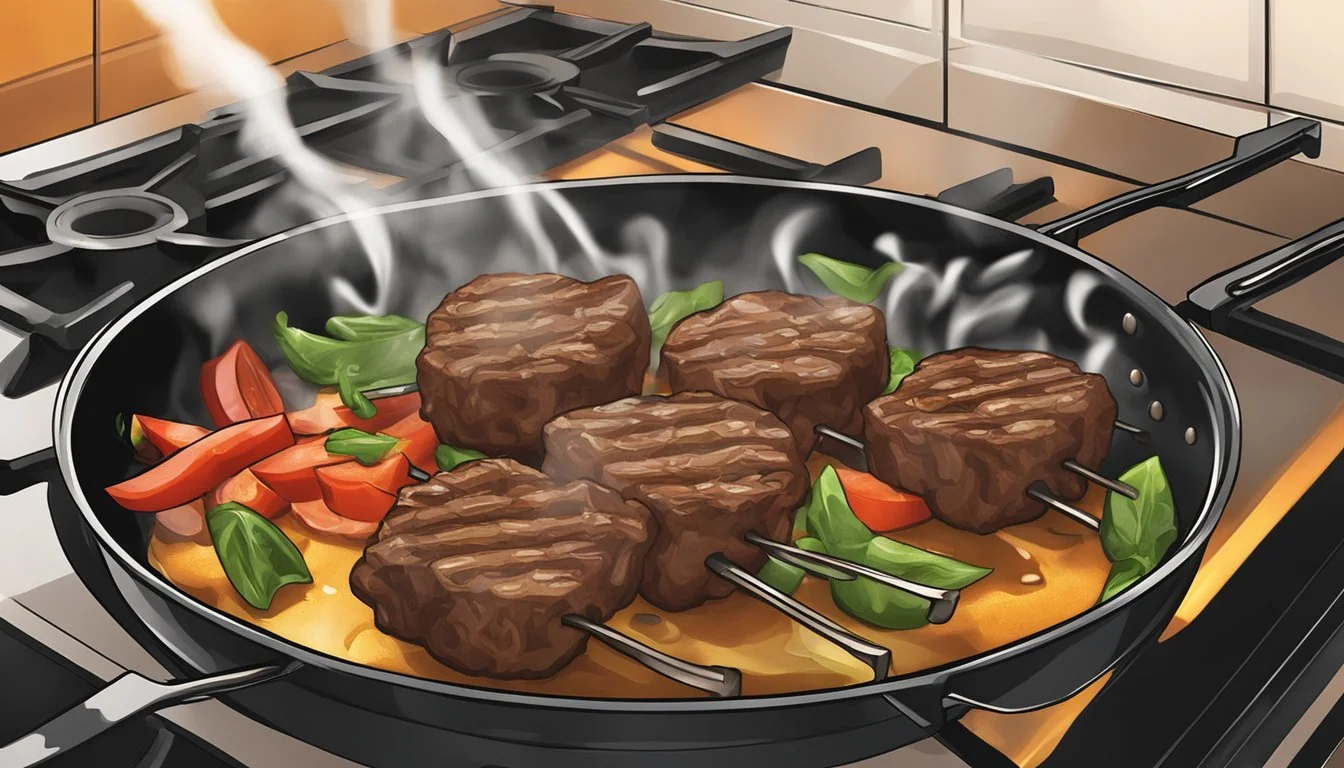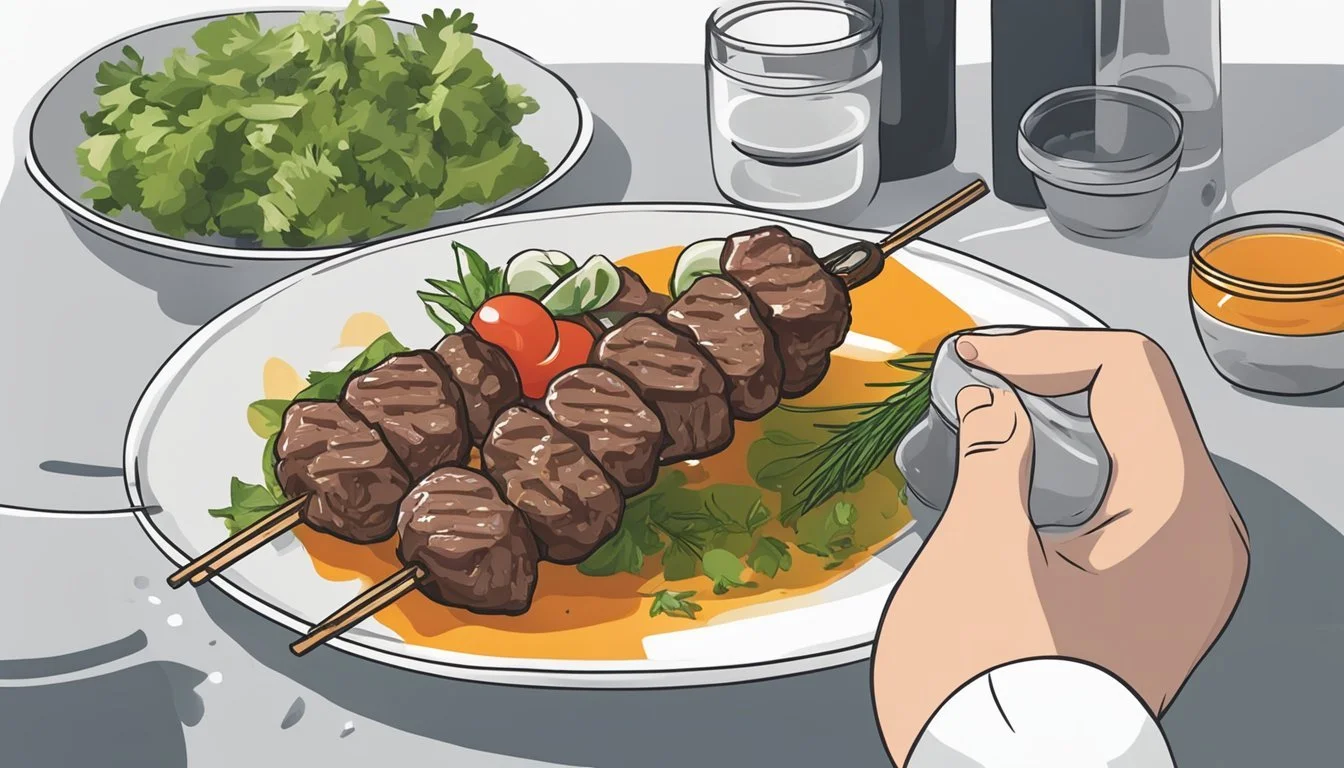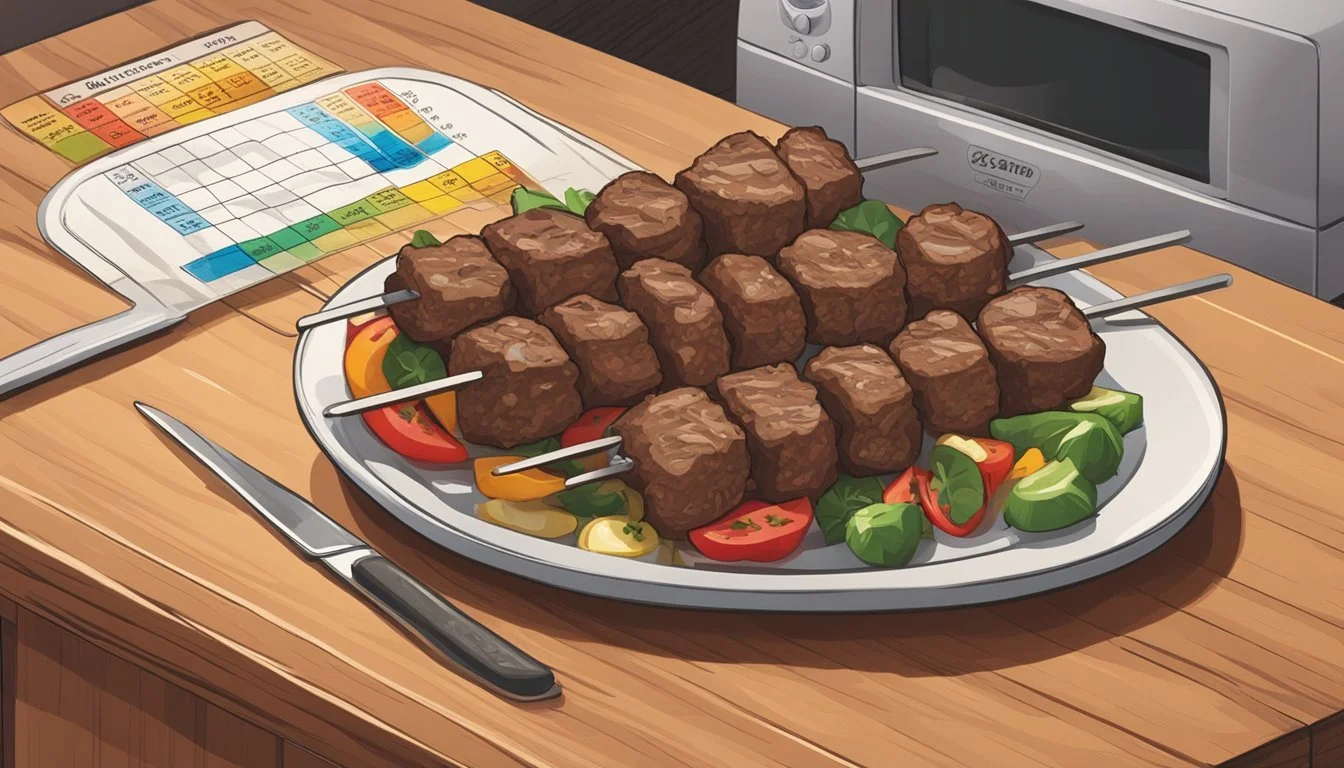How to Reheat Beef Kebabs for Perfect Juiciness
When hunger strikes and there's leftover beef kebab in the fridge, knowing how to reheat it properly can make all the difference. Reheating beef kebabs requires precision to maintain their juicy texture and rich flavors. Using an oven, preheat it to 350°F and wrap the kebab meat in aluminum foil to lock in moisture, ensuring a succulent and delightful taste.
For a quicker method, the microwave is an efficient option. By placing the kebab meat in a microwave-safe dish with a splash of water and covering it tightly, you can effectively reheat it in just a few minutes. Alternatively, warming the kebab meat in a skillet on the stove with a bit of oil and covering the pan with a lid helps retain its moisture and prevents it from drying out.
Another appliance to consider is the air fryer, which can give your reheated kebab a slight crispy edge while keeping the inside tender. Regardless of the method chosen, the key is to reheat the beef kebabs slowly and evenly, avoiding overheating which can result in dry and tough meat.
Preparatory Steps Before Reheating
Properly handling, storing, and thawing your leftover beef kebabs is essential to ensure they remain flavorful and safe to consume. This section covers important steps to take before you begin reheating.
Handling Leftover Kebabs
When handling leftover kebabs, it is critical to ensure they are cooled and stored properly within two hours of cooking. Use clean utensils and containers to prevent contamination. Divide the kebabs into smaller portions before storing, which will make reheating easier and faster. Avoid leaving them out at room temperature for prolonged periods.
Storing for Optimal Freshness
For optimal freshness, store leftover kebabs in an airtight container. If planning to consume within a few days, place the container in the fridge. For longer storage, wrap each kebab tightly in aluminum foil or plastic wrap, and then place them in a freezer-safe bag before placing them in the freezer.
Proper wrapping helps maintain the moisture and flavor of the meat. Label containers with dates so you know when they were stored.
Thawing Frozen Kebabs
To thaw frozen kebabs safely, transfer them from the freezer to the fridge and let them sit overnight. This slow thawing process helps preserve the texture and taste of the meat. If pressed for time, use the defrost setting on your microwave, but monitor them closely to avoid partial cooking.
Never thaw beef kebabs at room temperature as this can lead to bacterial growth.
Reheating Beef Kebabs in the Oven
Reheating beef kebabs in the oven ensures an even distribution of heat and helps retain moisture. Follow these steps to achieve a juicy and flavorful result.
Preheat Oven to the Correct Temperature
To reheat beef kebabs, the oven should be preheated to 350°F (180°C). Preheating is crucial because it guarantees that the oven's heat is evenly distributed, which helps in reheating the beef kebabs thoroughly and consistently. A properly preheated oven also reduces the reheating time and helps retain the moisture and texture of the meat.
Proper Usage of Equipment
Use a baking sheet and aluminum foil for the best results. The beef kebabs should be wrapped in aluminum foil before placing them on the baking sheet. Wrapping the meat in foil traps the steam, keeping the kebabs moist and preventing them from drying out. Moreover, using a baking sheet allows for easy handling and cleanup after reheating.
Timing and Heat Distribution
Once the beef kebabs are in the preheated oven, they generally take about 10-15 minutes to reheat. It's important to check their internal temperature to ensure they reach at least 165°F (74°C) for safe consumption. Turn the kebabs halfway through the reheating process to ensure even heat distribution. This step guarantees that all sides of the kebabs are reheated uniformly, ensuring a consistently warm and delicious meal.
Reheating on the Stovetop
Reheating beef kebabs on the stovetop is an effective way to restore their flavor and texture. The following methods ensure even heating and help maintain the meat's juiciness.
Skillet Reheating Method
To reheat beef kebabs using a skillet, begin by selecting a non-stick frying pan. Heat the pan over medium heat, adding a splash of cooking oil, such as olive or coconut oil.
Arrange the kebab pieces in a single layer in the heated skillet for uniform warming. Allow the beef to sear gently for 2-3 minutes before turning each piece. Continue to heat for another 2-3 minutes until the beef is thoroughly warmed.
Maintaining consistent medium heat is critical. This prevents overcooking the exterior while ensuring the interior warms adequately. Avoid crowding the skillet, as this can result in uneven reheating.
Tools needed for this method:
Non-stick frying pan
Cooking oil
Spatula
Maintaining Meat Juiciness
Maintaining the juiciness of beef kebabs during stovetop reheating involves a few essential steps. Adding oil to the skillet helps retain moisture in the meat during the reheating process.
For added moisture retention, cover the skillet with a lid after placing the kebab pieces in the pan. The lid traps steam, reducing the risk of dryness. Ensure not to overheat, as excessive temperatures can dry out the beef.
Turning the kebab pieces multiple times during reheating helps in even heat distribution, preventing any section from becoming overly dry or burnt. Monitoring closely ensures that the meat remains succulent throughout the process.
Using a Microwave for Quick Results
Reheating beef kebabs in the microwave is a quick and easy method for bringing your meal back to life. Following microwave-safe practices and avoiding overheating are essential steps to ensure the meat remains juicy and delicious.
Microwave-Safe Practices
Start by separating the kebab meat from any salad or bread. This prevents the vegetables from becoming soggy and the bread from getting too hard.
Place the kebab meat on a microwave-safe dish. Using a damp paper towel, cover the meat to retain moisture. This helps prevent the meat from drying out during the reheating process.
It's important to set the microwave to medium power (around 50%). This allows the meat to warm evenly without cooking it further. Reheat the kebab meat for about 60 seconds initially.
After the first minute, check the temperature of the meat. If it's not hot enough, continue microwaving in 15-second intervals until the meat reaches the desired temperature.
Avoiding Overheating
To prevent the beef kebabs from becoming tough or overcooked, avoid reheating the meat all at once. Instead, follow a method of short, controlled heating periods.
Begin by setting the microwave at a lower power level. This helps to reheat the meat gently, preserving the texture and flavor. After each interval, check the meat's temperature and texture.
Using a food thermometer can be beneficial to ensure the meat reaches a safe internal temperature of 165°F (74°C). Overheating can lead to dry and chewy meat, so taking these extra steps can result in a much better texture.
By monitoring the reheating process closely, you can ensure your beef kebabs come out hot and juicy without being overdone.
Utilizing an Air Fryer
Reheating beef kebabs in an air fryer is a quick and efficient way to enjoy leftover meat. This method ensures even heating and can help maintain a crispy exterior.
Air Fryer Heating Instructions
To reheat beef kebabs in an air fryer, begin by setting the temperature to 400°F (200°C). Place the meat in a single layer within the air fryer basket to avoid overcrowding, which promotes even heating. Insert the loaded basket into the air fryer. Heat the kebabs for 2-3 minutes. Use a meat thermometer to check if the internal temperature reaches 165°F (74°C) for safe consumption. Remove and serve immediately for the best taste and texture.
Crispy Finish Considerations
Achieving a crispy finish can enhance the texture of reheated beef kebabs. Ensure that the kebabs are evenly spaced and not stacked, as this facilitates proper air circulation. To add a crispier exterior, lightly brush the kebabs with a small amount of oil before reheating. If they seem dry, a spritz of water can help retain moisture. Monitoring closely during reheating is crucial, as overcooking can lead to dryness. For added control, consider flipping the kebabs halfway through the reheating process to ensure an evenly crispy exterior.
Alternative Reheating Methods
Reheating leftover kebab meat can be done in various ways for different occasions like dinner or lunch. Here are a few alternative methods:
Grill
Using a grill is an efficient way to reheat kebab meat. Preheat the grill to a medium temperature. Place the meat on the grill and heat for 1-2 minutes on each side. This method keeps the meat juicy and enhances its smoky flavor.
Steaming
Steaming is another great option to reheat kebab meat without drying it out. Place the meat in a steamer basket over boiling water. Cover and steam for about 5-7 minutes. This method is particularly effective for maintaining the tenderness of the meat.
Skillet
Heat a skillet on medium heat and add a small amount of oil. Place the kebab meat in the skillet and heat for 1-2 minutes, stirring occasionally. To prevent the meat from drying out, cover the skillet with a lid and let the steam retain the meat’s moisture.
Microwave
While not the best for texture, a microwave can be used for convenience. Place the meat on a microwave-safe plate and cover it with a damp paper towel. Heat on medium power for 1-2 minutes, checking at intervals to avoid overcooking.
Oven
Preheat the oven to 350°F (about 180°C). Wrap the kebab meat in aluminum foil and place it on a baking tray. Heat in the oven for 10-15 minutes. Using a meat thermometer, ensure the internal temperature reaches 165°F for safety.
Using these methods helps ensure that your leftover kebab meat is heated thoroughly while retaining its flavor and texture.
Final Touches and Serving
To serve reheated beef kebabs perfectly, consider restoring their freshness, enhancing their flavor with garnishes, and ensuring they are safe and enjoyable.
Restoring Original Freshness
After reheating, it’s crucial to bring back some of the kebab's original tenderness and juiciness. Cover the beef kebabs with a damp paper towel for a minute after microwaving to retain moisture.
Add a splash of olive oil to the pan when reheating on the stovetop to keep the meat moist. For oven reheating, cover the kebabs with foil to prevent them from drying out.
Marinating the reheated kebabs in a light Mediterranean sauce like yogurt or lemon juice can also help restore their original freshness.
Garnishing for Enhanced Flavor
Serving beef kebabs with appropriate garnishes not only makes the dish visually appealing but also elevates its taste. Fresh lettuce, tomato, and pita bread can complement the rich flavor of beef.
For a traditional touch, include sides like hummus and yogurt sauce. A drizzle of olive oil and a sprinkle of freshly chopped herbs such as parsley or mint enhance the flavor profiles.
Create a balanced plate that includes carbs, proteins, and vegetables to enhance the dining experience for any guests.
Ensuring Safety and Enjoyment
Safety should be a priority when serving reheated beef kebabs. Always reheat to an internal temperature of at least 165°F to ensure that the meat is safe to eat. Use a food thermometer for accuracy.
Keep the reheated kebabs warm by placing them in a covered dish. Serve promptly after reheating to maintain the best texture and flavor.
Position dishes and utensils conveniently so guests can easily build their own kebab wraps with pita bread and various condiments, ensuring a delightful and safe dining experience.
Maintaining safe handling and proper garnish ensures that your reheated kebabs remain delicious and inviting.
Understanding Kebab Nutrition
Beef kebabs are a popular dish enjoyed globally, with a diverse nutritional profile.
Calories: On average, a single skewer of beef kebab can contain approximately 200-300 calories. The exact amount depends on portion sizes and ingredients.
Fat: Beef kebabs often include fat from the meat and any used marinades. Olive oil is a common ingredient, adding healthy fats to the mix.
Protein: Beef kebabs provide a substantial amount of protein, essential for muscle repair and growth. A single skewer can provide around 20-25 grams of protein.
Spices: Garlic, cumin, and paprika are frequently used, enhancing flavor and offering antioxidants. These spices can contribute to the nutritional and health benefits of kebabs.
Vegetables: Beef kebabs often come with vegetables such as onions and bell peppers, adding vitamins and fiber.
Accompaniments: Common sides include rice, which adds carbohydrates, and salads.
Quality: The nutrition profile can vary based on the quality of the ingredients. Fresh, high-quality meat and vegetables contribute to a healthier and more nutritious meal.
Lamb Alternative: Lamb is another common meat in kebabs, offering a similar nutritional profile but sometimes with a higher fat content.
Regular consumption of beef kebabs can fit into a balanced diet, especially when prepared with high-quality, fresh ingredients.
Creative Uses for Leftover Kebabs
Leftover kebabs don't need to go to waste. There are many delicious ways to repurpose them into new meals.
Breakfast is a great time to use leftover kebab meat. Simply chop the meat into small pieces and add it to an omelet. The savory flavors blend well with eggs, onions, and peppers, creating a hearty start to the day.
Another option is to make a sandwich. Shred the leftover kebab meat and layer it onto toasted bread with hummus, lettuce, and tomato. This makes for a quick and satisfying lunch.
Tacos are also a fantastic use for leftover kebabs. Warm the meat and place it in tortillas with your favorite toppings like salsa, guacamole, and cheese. This method brings a fresh twist to the traditional kebab flavors.
Salads benefit from the addition of kebab meat as well. Toss the shredded meat with mixed greens, cucumbers, and a tangy dressing. It adds a boost of protein and makes the salad more filling.
For a comforting meal, consider turning leftover kebabs into a soup. Add the meat to a stew with vegetables and broth. The flavors of the kebabs will enhance the soup, making it rich and flavorful.
Finally, a simple yet tasty idea is to use the meat in a pita wrap. Combine the kebab meat with tzatziki sauce, cucumbers, and onions inside a pita bread. This quick meal is both satisfying and easy to prepare.
Using leftover kebabs in these creative ways ensures no food goes wasted and keeps your meals exciting and different.





